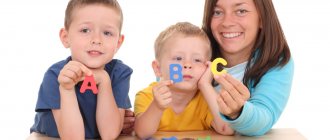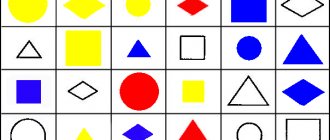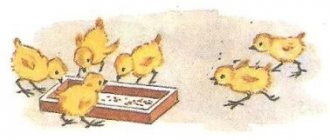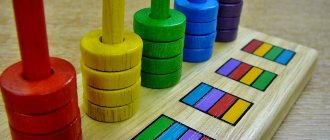Diagnostics of mathematical development of older preschool children
Diagnostics of mathematical development of older preschool children
Theoretical part:
1.Diagnostic functions in preschool mathematics education
Diagnostics in preschool mathematics education can be of two types: express diagnostics and system diagnostics. Each of these types of diagnostics has its own functions.
Express diagnostics
– This is a one-time examination, usually carried out independently of the pedagogical learning process. The functions of this type of diagnosis are to give a fairly current picture of the child’s level of mathematical development today, as well as the “zone of proximal development.” Express diagnostics determines a complex of internal mental and external environmental factors. Another function of express diagnostics is to determine the current level of mathematical development of a child entering first grade.
System diagnostics –
This is the systematic “tracking” of a child by a teacher in the process of systematically working with him. The functions of system diagnostics make it possible, based on its results, to build a long-term forecast for the development of a child’s mathematical abilities. There is also a function for tracking the individual “speed” of progress in mathematical development and predicting the child’s zone of proximal development. Systemic diagnostics is an integral part of the process of learning and development of a child. In the process of systematic educational work with a child, built on the principles of developmental education, all areas of development (intellectual, emotional, social, physical, etc.) are in the sphere of constant attention and observation of the teacher and psychologist. The function of tracking a child’s mathematical development allows you to provide the necessary assistance in a timely manner, both for the purpose of correcting and compensating for development, and for the purpose of preventing further school maladjustment.
Pedagogical diagnostics is a mechanism for identifying individual characteristics and prospects for personal development. With the help of pedagogical diagnostics, the educational process is analyzed and the results of the activities of both the child and the teacher are determined. The goal of diagnostics is to obtain more complete information about the individual characteristics of children’s development, on the basis of which recommendations can be developed for educators, psychologists, and parents to prepare children for school and select the optimal forms of further education at the stage of primary general education.
Diagnostic functions:
analytical –
identifies cause-and-effect relationships in the educational process between conditions and learning outcomes;
actually diagnostic
– contributes to the study of the level of training, education and development of the child, as well as the level of professional competence of the teacher;
evaluative
– involves qualitative and quantitative assessment of the activities of participants in the pedagogical process;
correctional
– aimed at correcting (changing) the actions of the teacher and the child in order to eliminate the negative consequences of learning;
orientational
– provides for the prevention of negative consequences of training and the identification of new goals;
informational
– aims to constantly inform participants in the pedagogical process about the positive results of pedagogical diagnostics.
2. Methodology for diagnosing the level of mathematical development of a child
The purpose of diagnostics is to monitor children’s mastery of the basic methods and techniques of cognitive (mathematical) activity, practical actions, content, verbal expression of methods and results of practical and mental actions. During the diagnosis, the attitude of children to cognitive and creative mathematical tasks is clarified: delight and maximum activity or indifference; the ability to show creativity or the desire to simply reproduce a given task, etc.
Diagnostics are carried out based on the following indicators of three expected levels of children’s mastery of mathematical content:
— the child’s mastery of the practical actions of comparison, equalization, counting, calculations, measurement, classification and seriation, modification and transformation, etc.;
- the nature of children’s ideas about relationships, dependencies of objects in size, quantity, shape, location in space, etc.;
- level of verbal expression of methods of practical actions: use of terminology, structure and construction of sentences, originality and accuracy of statements;
— the degree of independence and creative manifestations in the course of mastering and transferring mathematical knowledge and skills to new conditions.
As an example, I propose a method for diagnosing the mathematical development of children of middle preschool age (compiled by I.N. Cheplashkina, L.Yu. Zueva - St. Petersburg, “Accent”, 200 6).
The tasks are aimed at identifying the following skills:
- determine the shape, recreate the figure from parts (elements);
- use numbers: count, equalize, navigate in numbers;
- move through the labyrinth;
- solve logical problems, show guesses, explain your actions.
Criteria for development levels
- Perception, selection, selection of shapes (square, rectangle, triangle), recreating them from elements (parts).
Low level.
Highlights, names figures (confuses names). Doesn't have the ability to recreate. Names individual words.
Average level.
Identifies and names figures. Doesn’t know how to recreate (makes certain attempts). The actions are explained schematically.
High level.
Selects, names figures, explains actions. Recreates geometric shapes from parts.
- Ability to determine quantity using numbers; practically establish equality, distinguish, name numbers, their sequence.
Low level.
Determines quantity, makes mistakes in using numbers after four, distinguishes numbers. Does not establish equality.
Average level.
Uses numbers accurately, distinguishes and partially names numbers, does not establish equality, explanations are fragmentary.
High level.
Uses numbers accurately, knows the sequence of numbers, equalizes, and explains actions.
- Orientation from yourself when determining the direction of movement (with change) through the labyrinth.
Low level.
He leads with a pencil, but does not indicate the direction. Makes several attempts.
Average level.
Names changes in the direction of movement, makes mistakes. Explains his actions.
High level.
Accurately identifies and names directions.
- The ability to alternate and distribute objects (by color, shape, quantity); practically focus on the algorithm specified verbally, performing actions based on a visual basis (drawing).
Low level.
The target of the action is not aware. Performs chaotic actions.
Average level.
Carries out actions according to the picture, adheres to the goal, explains. The result is only partially achieved.
High level.
Solve problems correctly and offer options. Explains.
- Manifestation of guesswork and ingenuity when solving logical problems included in a situation-game.
Low level.
Reflects everyday understanding of the situation.
Average level.
Offers guesses, tells stories, makes mistakes.
High level.
Completes the task mentally, proves the correctness of the decision.
- Emotional attitude to the proposed tasks. An outward expression of interest.
Low level.
Indifferent, interested in pictures.
Average level.
Rejoices at success.
High level.
Tries to analyze his actions, asserts their correctness. Rejoices at success.
The procedure for carrying out diagnostics, explanations of tasks, types of possible assistance, for each task may have its own characteristics.
Before diagnosis, children should be familiarized with similar tasks.
- The examination is carried out in the first half of the day from 9 to 12 o'clock, on Tuesday or Wednesday, when the maximum level of children's performance during the week is observed.
- The examination is carried out in a calm, supportive environment.
- Only one specialist (either a teacher or a psychologist) works with a child at a time; this is due to the fact that cross-examination of several adults often makes contact difficult and does not allow obtaining objective results.
- If a more in-depth examination by specialists (speech therapist, psychologist) is necessary, it is more advisable to do this at another time.
- All necessary supplies, manuals and materials are not lying on the table at which the child will work; they are laid out in a certain order on a separate table.
- Parents can be present during the examination; it is advisable for them to sit with their backs to the child. (This time can be used for parents to answer survey questions.)
During the examination, teachers:
- do not rush the child, do not rush with a hint;
- do not show their displeasure or dissatisfaction;
- do not emphasize negative results and analyze the results together with the parents in the presence of the child.
3. Methods for reporting diagnostic results
To correctly determine the level of mathematical preparation, it is necessary to diagnose the entire proposed set of tasks and draw conclusions based on the total result. This is important for further correction in order to select those tasks that the child cannot cope with.
Design methods may vary. Most often, levels are assigned a certain number of points. For example, a low level is from 1 to 3 points, an average level is from 4 to 6 points, a high level is from 7 to 9 points. Each level is allocated a certain number of points. To assign points, you must carefully observe the test taker’s performance of the task and record his actions, behavior, attitude to the task, speech and other parameters that determine the level in this task. To record the parameters, you can use pre-prepared forms in which the parameters are indicated, and the teacher, watching the child complete the task, makes notes on the form. Various tables are used to record the completion of each task operation.
It is important that each test task is assessed and the result recorded. After evaluating each completed task, the results in points for each task are recorded in a summary table. Based on the result of the total score, a conclusion is made about the level of mathematical development of each child and a form is drawn up for recording individual results for the entire test. After that, a form for group registration of test results is drawn up. The forms indicate where, when, for what purpose the test was conducted and what content it was, how many children were tested, and what skills the tasks were aimed at identifying. We draw conclusions individually for each child and in general about the entire tested group. This is important in order to identify pedagogical omissions (in case the majority of children did not cope with the same task).
4. Taking into account diagnostic results in pedagogical work with children
The diagnostic results allow the teacher to more accurately and completely take into account the individual characteristics of each child. If the pedagogical influence is built taking into account the level of development achieved at the previous stage of the child’s life, and is based on the strengths of his personality, then this influence ensures the successful inclusion of the child in educational and cognitive activities, contributes to the formation of a positive attitude towards this activity, and significantly influences the formation of diligence, hard work, activity. And also, taking into account diagnostic results stimulates the development of basic mental processes and ensures the correct construction of special corrective measures.
Without taking into account the diagnostic results, the initial developmental deviations only worsen, which will be almost impossible to compensate in the future.
Correctional and developmental education is built taking into account the diagnostic results in order to pay increased attention from the teacher to the development of those mental processes, the formation of which in a given child is either somewhat delayed or does not quite correspond to our approximate ideas about the norm of development. The diagnostic results make it possible to determine the nature of the goal of correctional and developmental work in mathematics classes. The nature of the goal could be as follows:
— intellectual-perceptual
: correction and development of adequate perception of information presented visually and auditorily; correction and development of skills of an analytical nature - essential characteristics, separation of the main from the secondary, identification of patterns, distribution according to the selected characteristics (classification) and generalization of the results of activity (in subject-practical or verbal form);
— regulatory-dynamic
: formation of elements of educational and cognitive activity - understanding of the assigned educational task, independent selection of the necessary means in accordance with the task, activity planning and self-analysis (the ability to find and correct errors), stimulation of educational and cognitive motivation, cognitive interest and educational independence;
— psychophysiological
: development, correction or compensation of disturbances in the activity of analyzers, development of fine motor skills, kinesthetic sensitivity, spatial coordination.
The diagnostic results are taken into account when assessing the level of professional competence of the teacher, in order to provide timely assistance in mastering the necessary techniques.
Practical part:
1. To examine the level of development of mathematical concepts of older preschoolers and give pedagogical recommendations
Express diagnostics of the cognitive development of preschool children and the level of development of mathematical concepts in children of senior preschool age.
Diagnosis was carried out on the basis of a kindergarten. In total, the study involved 25 children aged 5 years 4 months - 5 years 10 months.
Example 1
. "Organizing"
Purpose of the task.
To identify children’s understanding of counting objects and their ordering.
Materials.
Cardboard circles with a diameter of 5 cm with dots. The circles are placed in front of the child in disorder.
Exercise.
In some circles there are few dots, in others there are many. Now the circles are in disarray. Think and arrange these circles in a row in order. When you look for this or that order, do not forget that there are points on the circles.
Execution method.
You should not tell your child the principle of ordering. Completing the task independently will show the level of formation of his idea of orderliness.
Assignment rating:
Level 1 - the task was completed completely correctly;
Level 2 - 1-2 mistakes were made;
Level 3 – 3-4 mistakes were made;
Level 4 – more than 5 mistakes were made.
Example 2.
"Primary mathematical concepts"
Purpose of the task.
Determine children’s understanding of ratios:
more by, less by;
about quantitative and ordinal counting, about the shape of the simplest geometric figures.
Materials.
Seven of any objects or their images on a flannelgraph; the objects can be either the same or different.
Execution method.
To complete the task, the child is given a piece of paper and a pencil. The task consists of several parts. They are offered sequentially.
Tasks.
A
. Draw as many circles on the sheet as there are objects on the board.
B.
Draw one more squares than circles.
IN.
Draw two fewer triangles than circles.
G.
Draw a line around six squares.
D.
Fill in the fifth circle.
Assignment assessment
(the quality of performance of all tasks in total is assessed):
Level 1 - the task was completed completely correctly;
Level 2 - 1-2 mistakes were made;
Level 3 – 3-4 mistakes were made;
Level 4 – more than 5 mistakes were made.
Example 3
Purpose of the task.
Conduct diagnostics of the ability to analyze the conditions of the presented task, in this case of a practical nature (plan the course of its solution, choose adequate actions, critically evaluate the result obtained). The task also determines the visual adequacy of determining the shape of a figure, spatial mobility of thinking - the ability to mentally move and arrange parts, and the adequacy of visual assessment of the size of figures.
Materials.
A white sheet of paper with an image of the outline of a boat with a sail and colored geometric shapes: 4 squares 2x2 cm, 4 right isosceles triangles with a leg 2 cm, all the same color.
2 cm
6cm
Exercise.
Part 1
. “Color” the boat, but not with pencils, but with these figures. The figures must be placed inside the boat so that they do not extend beyond the image.
Part 2.
Evaluate the quality of the task - was everything done correctly? If the child himself does not notice the mistakes made (the figures do not fit together, they go beyond the outline), the teacher asks if the child wants to make a new boat better than this one. If the answer is negative, the teacher does not insist on it.
Assessment of the task.
A
The method of completing the task is assessed: whether the child first thought about its implementation, planned it, or worked without any system, by trial and error.
B.
The rationality of the placement of figures is assessed.
IN
.Criticality in assessing task performance is assessed.
G
. The desire and readiness to correct mistakes is assessed.
D.
The pace of activity is assessed.
1st level - the figures are laid out correctly and quickly (the child instantly analyzed the task and began to complete it);
Level 2 - the outline is filled out correctly, but the child worked by trial and error, so he spent more time; corrected himself in the process of work;
3rd level - only part of the outline is filled correctly, some figures go beyond its outline; when evaluating work, the child does not notice mistakes, but when the teacher draws his attention to them, he is ready to correct them;
Level 4 - the outline is filled chaotically, most geometric shapes go beyond its outline, errors are not noticed, and there is no desire to do better when pointing them out.
Example 4.
"Checking in the house"
Purpose of the task.
Identify children’s ability to consider a situation from different angles, the ability to switch from one solution found to the search for another.
Materials.
A house is drawn in advance on a board or on a large sheet of paper,
cards with large images of the “tenants” of the house; Each child is given a sheet of paper with a picture of the same house and a felt-tip pen.
Exercise.
Part 1 (educational).
The house has six floors. There are three rooms on each floor. Each room has one resident: the teacher shows the images - a dot, a stick and a tick. On all floors they live in different orders. On the top floor in the first room on the left there is a dot (draws a dot in the window), in the middle room there is a wand (draws a wand).
- Tell me who lives in the last room? (The children name a tick, and the teacher draws it.) Now draw on your piece of paper who lives where on the sixth floor. (Children draw, the teacher checks the correctness of the drawing.)
- Now we will populate the fifth floor with residents: a dot also lives in the first room. Think about how you need to house the wand and the tick so that they do not live in the same order as on the sixth floor. The placement of the “tenants” is drawn in the windows of a large house, and then the children draw them in their own homes. This concludes the training part of the task.
Part 2 (main).
- There are still four floors left. Populate them yourself so that on each floor there lives one dot, one stick and one tick, but in a different order. Children complete the task independently.
Assessment of the task.
1st level - the task was completed correctly: all 4 accommodation options were found that do not repeat the “occupancy” of the fifth and sixth floors;
2nd level - 2-3 different placement options were found out of four possible;
Level 3—one placement option out of four possible has been found;
Level 4 - no independent solutions were found: the solutions from the training stage were repeated or the work was not completed (the floors remained uninhabited).
Example 5.
Coloring shapes
Purpose of the task.
Demonstrate the ability to classify visual material according to an independently found basis.
Determine the degree of adequacy of visual perception of form and the ability to mentally move and combine figures to determine their equality. Materials.
Each child receives a drawing with a number of figures, felt-tip pens or pencils.
Exercise.
Identical figures must be painted with the same color. The color is chosen independently. The number of groups of identical figures the child finds, the number of colors he uses.
Assessment of the task.
1st level - classification is done correctly; three groups of different figures are identified (3 isosceles triangles, 4 equilateral and 3 rectangular).
Level 2 - one error (failure to distinguish identical figures in a straight and rotated position; or failure to distinguish identical figures in a straight and mirror position);
Level 3 - two errors (not distinguishing identical figures in direct and rotated positions and not distinguishing figures in direct and mirror positions);
Level 4 - three errors (failure to distinguish identical figures in a straight and rotated position, in a straight and mirror position, and also failure to distinguish between different figures); senseless, chaotic coloring of figures.
results
express diagnostics of the cognitive development of preschool children and the level of formation of mathematical concepts of children of senior preschool age in the senior group of kindergarten
Example 1
. "Organizing"
| I.F. | level | I.F. | level | I.F. | level |
| A.Sh. | IV | VC. | II | M.D. | I |
| A.Z. | I | D.V. | I | N.Z. | II |
| A.K. | I | D.D. | III | N.P. | II |
| A.P. | III | D.L. | I | O.V. | II |
| A.Le. | I | YES. | I | THOSE. | II |
| A.L. | I | Z.R. | I | T.A. | I |
| A.M. | II | K.B. | I | Yu.Z. | I |
| V.D. | I | K.N. | I | ||
| V.N. | II | L.S. | I |
Example 2.
"Primary mathematical concepts"
| I.F. | level | I.F. | level | I.F. | level |
| A. Sh. | III | VC. | II | M.D. | I |
| A.Z. | I | D.V. | II | N.Z. | I |
| A.K. | I | D.D. | III | N.P. | I |
| A.P. | III | D.L. | I | O.V. | III |
| A.Le. | I | YES. | II | THOSE. | II |
| A.L. | I | Z.R. | I | T.A. | II |
| A.M. | I | K.B. | I | Yu.Z. | I |
| V.D. | III | K.N. | I | ||
| V.N. | I | L.S. | II |
Example 3.
| I.F. | level | I.F. | level | I.F. | level |
| A.Sh. | III | VC. | II | M.D. | I |
| A.Z. | I | D.V. | II | N.Z. | I |
| A.K. | I | D.D. | III | N.P. | I |
| A.P. | IV | D.L. | II | O.V. | II |
| A.Le. | I | YES. | II | THOSE. | II |
| A.L. | I | Z.R. | I | T.A. | II |
| A.M. | I | K.B. | I | Yu.Z. | II |
| V.D. | III | K.N. | I | ||
| V.N. | II | L.S. | II |
Example 4.
"Checking in the house"
| I.F. | level | I.F. | level | I.F. | level |
| A.Sh. | III | VC. | I | M.D. | I |
| A.Z. | II | D.V. | I | N.Z. | I |
| A.K. | I | D.D. | III | N.P. | II |
| A.P. | IV | D.L. | III | O.V. | III |
| A.Le. | II | YES. | I | THOSE. | I |
| A.L. | II | Z.R. | II | T.A. | I |
| A.M. | II | K.B. | II | Yu.Z. | II |
| V.D. | I | K.N. | II | ||
| V.N. | II | L.S. | I |
Example 5.
Coloring shapes
| I.F. | level | I.F. | level | I.F. | level |
| A.Sh. | II | VC. | I | M.D. | II |
| A.Z. | I | D.V. | II | N.Z. | II |
| A.K. | II | D.D. | II | N.P. | II |
| A.P. | II | D.L. | I | O.V. | III |
| A.Le. | I | YES. | II | THOSE. | I |
| A.L. | I | Z.R. | I | T.A. | I |
| A.M. | I | K.B. | II | Yu.Z. | II |
| V.D. | I | K.N. | II | ||
| V.N. | I | L.S. | I |
Pivot table
| Example 1 | Example 2 | Example 3 | Example 4 | Example 5 | Bottom line | |
| A.Sh. | IV | III | III | III | II | 15 |
| A.Z. | I | I | I | II | I | 6 |
| A.K. | I | I | I | I | II | 6 |
| A.P. | III | III | IV | IV | II | 16 |
| A.Le. | I | I | I | II | I | 6 |
| A.L. | I | I | I | II | I | 6 |
| A.M. | II | I | I | II | I | 7 |
| V.D. | I | III | III | I | I | 9 |
| V.N. | II | I | II | II | I | 8 |
| VC. | II | II | II | I | I | 8 |
| D.V. | I | II | II | I | II | 8 |
| D.D. | III | III | III | III | II | 14 |
| D.L. | I | I | II | III | I | 8 |
| YES. | I | II | II | I | II | 8 |
| Z.R. | I | I | I | II | I | 6 |
| K.B. | I | I | I | II | II | 7 |
| K.N. | I | I | I | II | II | 7 |
| L.S. | I | II | II | I | I | 7 |
| M.D | I | I | I | I | II | 6 |
| N.Z. | II | I | I | I | II | 7 |
| N.P. | II | I | I | II | II | 8 |
| O.V. | II | III | II | III | III | 13 |
| THOSE. | II | II | II | I | I | 8 |
| T.A. | I | II | II | I | I | 7 |
| Yu.Z. | I | I | II | II | II | 8 |
Let us determine the level of cognitive development and formation of mathematical concepts of preschoolers.
High: 5-7 points
Average: 8-11 points
Low: 12 points or less.
Among the tested, 12 children were found to have a high level, 9 children an average level and 4 children a low level of cognitive development and the formation of mathematical concepts.
Recommendations: the tasks of the first three examples test the level of development of mathematical concepts of spatial and constructive thinking, and the last two reveal the level of development of the mathematical style of thinking. Consequently, children with an identified low level of cognitive development and the formation of mathematical concepts need correction using tasks that develop spatial and constructive thinking, as well as those aimed at developing a mathematical thinking style. After carrying out a set of corrective classes, repeated diagnostics are necessary. If a positive effect is not achieved, a more in-depth psychological diagnosis is recommended.
Literature:
- Beloshistaya A.V. Formation and development of mathematical abilities of preschool children: Issues of theory and practice. A course of lectures for students of preschool faculties of higher educational institutions. – M: Humanitarian Publishing Center VLADOS, 2003.- 400 p.
- Mathematical development of preschool children: Educational and methodological manual/Compiled. Z.A.Mikhailova, M.N.Polyakova, R.L.Nepomnyashchaya, A.M.Verbenets - St. Petersburg: Detstvo-Press, 2000. - 94 p.
- Mikhailova Z.A., Nosova E.A. et al. Theories and technologies of mathematical development of preschool children. – St. Petersburg: “Childhood-Press”, 2008. – 384 p., illus.
- https://adalin.mospsy.ru/l_01_00/l_01_08e.shtml
Source: comprehensive diagnostics of the levels of development of the “Program of education and training in kindergarten” edited by M. A. Vasilyeva, V. V. Gerbova, T. S. Komarova: diagnostic journal. Preparatory group / author-comp. N. B. Vershinina. - Volgograd: Teacher, 2010. - 35 p.
Age: pre-school group, senior preschool age.
| What is being studied? | Didactic games, exercises, questions | Contents of the diagnostic task | Criteria for evaluation |
| Knowledge of the composition of the number of the first ten (from individual units) | Didactic exercise “What will happen if...” | Assignment: think and give the correct answer: — What happens if you add 1 to 7? (You get the number 8.) — Add 1 to 9? — How to get the number 8 if there is a number 9? (Remove one unit.) - What happens if you add three units? (You get the number 3.) - What if you add 5 units? (Number 5.) | 3 points - the child knows the composition of the numbers of the first ten (from individual units) and how to obtain each number of the first ten by adding one to the previous one and subtracting one from the next one in the series. 2 points - the child knows the composition of the numbers of the first ten (from individual units), finds it difficult to complete tasks related to knowledge of obtaining a number by subtracting a unit from the next one in a series. 1 point - the child makes a large number of mistakes when completing tasks |
| Knowledge of numbers from 0 to 9; signs “=”, “-”, “+”. Ability to compose and solve problems in one step and use arithmetic symbols | Arithmetic problems (2-3). Material: numbers from 0 to 9, signs “=”, “-”, “+”; subject pictures | Tasks: 1. Look at the pictures (a vase with three tulips and a vase with three roses) and write a problem. Use numbers and symbols to show the solution to the problem. 2. Show a picture showing 6 inflated balloons and 4 burst ones. 3. Make up a condition and use numbers and signs to show the solution to the problem. | 3 points - the child independently composes the conditions of the problems using pictures and shows solutions using numbers and signs. 2 points - the child composes the conditions of the problems with the help of an adult, counts correctly, but does not always use the signs correctly (confuses the meaning of the signs “+” and “-”). 1 point - the child cannot formulate the conditions of the problem even with the active help of an adult, makes mistakes in calculations, does not understand the meaning of arithmetic signs. |
| Knowledge of months and the sequence of days of the week | 1. Didactic game “Live Week”. Material: cards with numbers from 1 to 7. 2. Didactic exercise “Name the month correctly.” | Tasks: 1. Choose any number. Tell me what day of the week it corresponds to. Lay out the days of the week according to the numbers and name them. 2. Tell me what month it is now? What is the name of the first (second) month of spring? | 3 points - the child copes with the tasks and does not make a single mistake; knows not only the current month, but also everyone else. 2 points - the child knows the sequence of the days of the week, finds it difficult to lay out the days of the week in accordance with the numbers, but after leading questions he copes with the task; only knows the current month. 1 point - the child did not cope with the task even after leading questions |
| Ability to name numbers in forward and reverse order, correlate numbers and quantities of objects | Didactic game “Delicious candies.” Material: sheet of paper with drawn numbers 0,3, 5, 8. 10 | Tasks: 1. Count within 10 forward and backward. 2. Look at the numbers written on a piece of paper and draw the corresponding number of candies next to each number. | 3 points - the child accurately counts forward and backward to 10, correctly completes task 2. 2 points - the child correctly counts forward to 10, makes omissions when counting backwards; makes no more than one mistake when performing task 2. 1 point - the child makes mistakes when counting forward and backward to 10, makes more than one mistake when completing task 2. |
| Ability to divide a circle, square, into two and four equal parts | Didactic game "Winnie the Pooh's Birthday". Material: 3 circles and 3 squares, 1 circle and 1 square divided into four parts equally | Exercise: Winnie the Pooh wanted to treat his guests to an orange and a cake, and began to divide them equally. Help Winnie the Pooh divide the orange and the cake into four equal parts. Think and answer: Is part of a circle or square more or less than the whole? | 3 points - the child independently divides a circle and a square into four equal parts and explains that the part is smaller than the whole. 2 points - the child finds it difficult to divide, but after the teacher’s prompting he completes the task correctly, noting that the whole is larger than the part. 1 point - the child cannot divide a circle and a square into equal parts. Does not understand the meaning of the concepts “part” and “whole” |
| The ability to count (count out) objects within the range of 10-20. Use ordinal and cardinal numbers | Didactic exercise “Funny toys”. Material: 15 (18) different small toys | Tasks: arrange (put) all the toys in order and count them. - Count all the toys. - How many toys are there in total? -Which one is the bear? - And the ball? And so on. | 3 points - the child did not make a single mistake. 2 points - the child makes mistakes in ordinal numbers. 1 point - the child makes a lot of mistakes |
| Ability to measure the length of objects using a conventional measure | Didactic exercise “Paths”. Material: three tracks of different lengths, a strip of paper 3 cm long - a conventional measurement | Task: look at the paths. - Which of these paths do you think is the longest and which is the shortest? - How to check this? | 3 points - when completing a task, the child independently applies a conventional measure, compares the results obtained and draws a conclusion. 2 points - when measuring length, the child uses a conventional measure; after additional instructions from the teacher, he compares the results independently. 1 point - the child has no idea of the concept of length, does not know how to use a conventional measure |
| Ability to navigate on a sheet of paper in a box | Game "Magic Point". Materials: a sheet of checkered paper with a dot on it, a simple pencil | Task: from a given point, measure two cells up, two cells to the right, two cells up, one cell to the right, four cells down, one cell to the left, one cell up, one cell down, one cell to the left | 3 points - the child completed the task and did not make a single mistake when moving the point. 2 points - the child completed the task, but made 1-2 mistakes when moving the point (for example: left or right). 1 point - the child did not cope with the task, made more than three mistakes |
High level - 20-24 points;
Average level - 13-19 points;
Low level - 8-12 points.
| Download a ready-made calculation using this method | Order a ready-made calculation using this method | Ask us a question about this method |
At the moment we do not have a ready-made calculation for this method, perhaps it will appear later. If you want to order an exclusive calculation using this method with your conditions or in combination with other methods, write to us by clicking on the second link. If you think that the methodology contains unreliable data or you have questions about conducting research on it, click on the third link.








